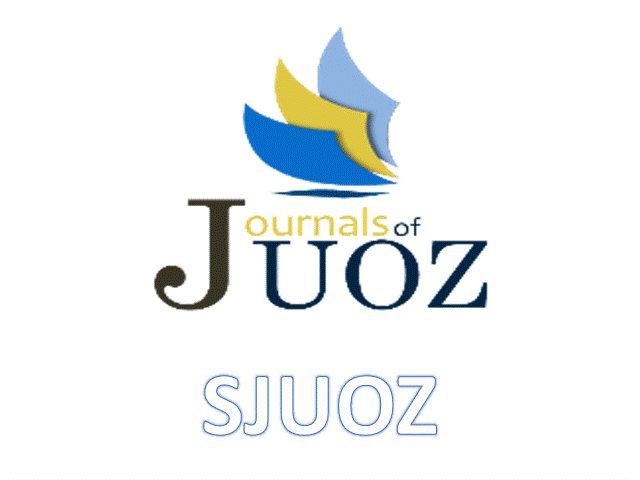Molecular Identification and Management of Rhizoctonia Fragariae the Pathogen of Black Root Rot of Strawberry Plant
DOI:
https://doi.org/10.25271/2017.5.2.364Keywords:
Strawberry, Rhizoctonia fragariae, black root rot, PCRAbstract
Strawberry plants are susceptible to a large number of pests and diseases and this can affect the quality and yield value of the fruit. Black root rot is an important disease of strawberry caused by a complex of fungi including Rhizoctonia. The most recognizable species of Rhizoctonia are R. solani and R. fragariae which are multinucleate and binucleate species, respectively. This work is aimed to isolate, identify and control the strawberry root rot caused by R. fragariae. Infected strawberry samples were collected from Erbil, Slemani, Duhok and Garmiyan Provinces. The identification of isolated fungi was achieved by using traditional methods along with molecular methods using polymerase chain reaction (PCR). In the later method, specific primers were designed and used to identify Rhizoctonia species. Several disease management options, including biological by using two species of Trichoderma, and chemical methods using Pristine fungicide, were also investigated. Sampling of strawberry plants revealed that the disease is prevalent in Kurdistan region and the isolated fungi, R. solani, Rhizoctonia sp., and R. fragariae, were pathogens of the disease causing crown and root rot of strawberry. PCR amplification was confirmed the identification of the species of Rhizoctonia. The results of control methods revealed that the most effective treatments were achieved using the fungicide followed by the use of the combination of T. harzianum and T. viride.
Downloads
References
Aly, M. and Manal, Y. H. 2009. Vesicular-arbuscular mycorrhiza and Trichoderma viride as deterrents against soil-borne root rot disease of sugar beet. Sugar Technology 11: 387-391.
Botha, A., Denman, S., Lamprecht, S., Mazzola, M. and Crous, P. 2003. Characterisation and pathogenicity of Rhizoctonia isolates associated with black root rot of strawberries in the Western Cape Province, South Africa. Australasian plant pathology. 32: 195-201.
Barbetti, M. 1989. Response of subterranean clover cultivars to Phytophthora clandestina. Phytophylactica. 21: 65-67.
Bahram K.H.and Mohammed, S. M. T. 2006. A comparison between five varieties of strawberry to determine the best fitted one to location of Grdarasha and Ankawa / Erbil. Kirkuk university journal scientific studies. 1 (1): 76-89
Elad, Y., Chet, I. and Henis, Y. 1981. Biological control of Rhizoctonia solani in strawberry fields byTrichoderma harzianum. Plant and Soil. 60: 245-254.
Fang, X., FIinnegan, P. M. and Barbetti, M. J. 2013. Wide variation in virulence and genetic diversity of binucleate Rhizoctonia isolates associated with root rot of strawberry in Western Australia. Plos One 8 (2) : 1-14.
Fang, X., Phillips, D., Li, H., Sivasithamparam, K. and Barbetti, M. 2011. Severity of crown and root diseases of strawberry and associated fungal and oomycete pathogens in Western Australia. Australasian plant pathology. 40: 109-119.
Fernandez, M.R. and Chen, Y. 2005. Pathogenicity of Fusarium species on different plant parts of spring wheat under controlled conditions. Plant Disease 89: 164-169.
Giampieri, F., Tulipani, S., Alvarez-Swarez, J. M., Quiles, J. L., Mezzetti, B. and Battino, M. 2012. The strawberry: composition, nutritional quality, and impact on human health. Nutrition. 28: 9-19.
Gilman, J. C. A. 1957. Manual of Soil Fungi.. Iowa State College Press. Ames, Iowa.
Guerena, M. and Born, H. 2007. Strawberries: organic production. Available by ATTRA-NCAT http://attra. ncat. org/attra-pub/PDF/strawberry. pdf (verified March 25, 2011).
Harman, G. 2006. Overview of mechanisms and uses of Trichoderma spp. Phytopathology. 96: 90-94.
Harman, G. E., Howell, C. R., Viterbo, A., Chet, I. and Lorito, M. 2004. Trichoderma species - opportunistic, avirulent plant symbionts. Nature reviews microbiology, 2: 43-56.
Liston, A., Cronn, R. and Ashman, T. L. 2014. Fragaria: A genus with deep historical roots and ripe for evolutionary and ecological insights. American Journal of Botany. 101: 1686-1699.
Monte, E. 2001. Understanding Trichoderma: between biotechnology and microbial ecology. International Microbiology, 4: 1-4.
Romandini S., L. Mazzoni, F. Giampieri, S. Tulipani, M. Gasparrini, N. Locorotondo, B. Mezzetti, and S. Bompadre. 2013. Effects of an acute strawberry (Fragaria × ananassa) consumption on the plasma antioxidant status of healthy subjects. Journal of Berry Research 3: 169–179.
Sambrook, J. and Russel, D. W. 2001. Detection of DNA in agarose gels. Molecular Cloning: A Laboratory Manual. 2nd edition, Cold spring harbor laboratory press, 1546 pp.
Ullio, L. 2009. Common diseases of strawberries. www. dpi. nsw.gov.au/ Primefacts892. Industry and Investment NSW. 1832-6668.
Ullio, L. and Macarthur, E. 2011. Strawberry disease control guide. Agrecultural fact H3.3.1 third edition. 0725-7759
Verma, M., Brar, S. K., Tyagi, R., Surampalli, R. and Valero, J. 2007. Antagonistic fungi, Trichoderma spp.: panoply of biological control. Biochemical Engineering Journal. 37: 1-20.
Watanabe, T. 2010. Pictorial atlas of soil and seed fungi: morphologies of cultured fungi and key to species, CRC press.ISBN: 978-1-4398-3.
Xiangling, F., Phillips, D., Verheyen, G., Hua, L., Sivasithamparam, K. and Barbetti, M. J. 2012. Yields and resistance of strawberry cultivars to crown and root diseases in the field, and cultivar responses to pathogens under controlled environment conditions. Phytopathologia Mediterranea. 51: 69-84.
Xiao, C. L., and Ligard, D. E. 2004. Genetic and pathogenic analyses of Collectotrichum gloeosporioides isolates from strawberry and non-cultivated hosts. Phytopathology, 94 (5): 446 – 453.
Zhang, C., Liu, Y., Ma, X., Feng, Z. and Ma, Z. 2009. Characterization of sensitivity of Rhizoctonia solani, causing rice sheath blight, to mepronil and boscalid. Crop Protection.28: 381-386.
Zhong, S., Xu, J. M., Yin, S. L., & Zhang, G. Z. (2016). First Report of Root Rot on Strawberry Caused by Binucleate Rhizoctonia AG-A in China. Plant Disease, 100 (1): 225.
Downloads
Published
How to Cite
Issue
Section
License
Copyright (c) 2017 Brwa A. Aziz, Qasim A. Marzani

This work is licensed under a Creative Commons Attribution 4.0 International License.
Authors who publish with this journal agree to the following terms:
- Authors retain copyright and grant the journal right of first publication with the work simultaneously licensed under a Creative Commons Attribution License [CC BY-NC-SA 4.0] that allows others to share the work with an acknowledgment of the work's authorship and initial publication in this journal.
- Authors are able to enter into separate, additional contractual arrangements for the non-exclusive distribution of the journal's published version of the work, with an acknowledgment of its initial publication in this journal.
- Authors are permitted and encouraged to post their work online.








